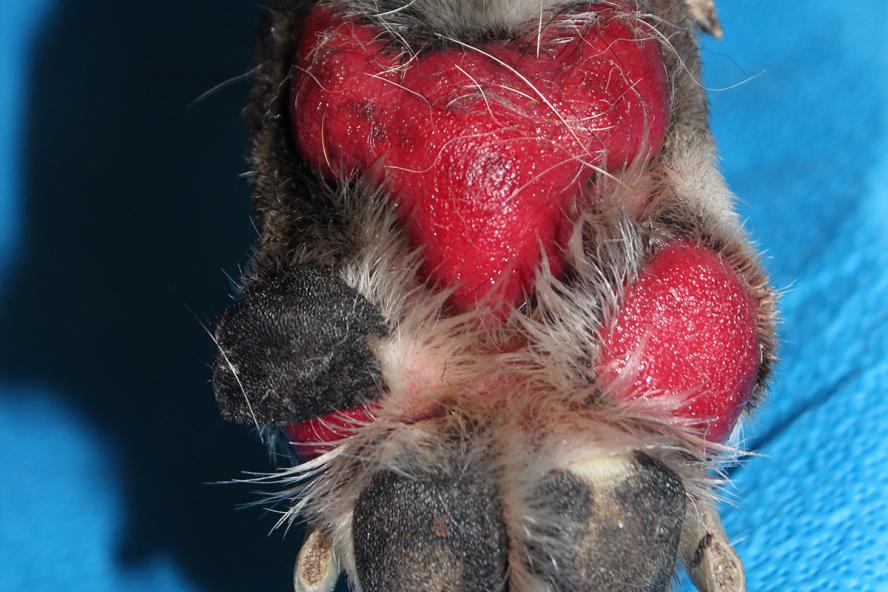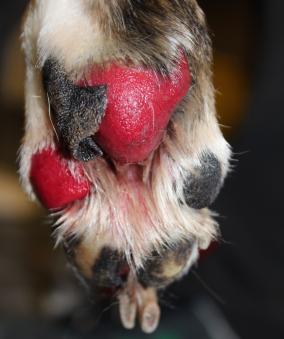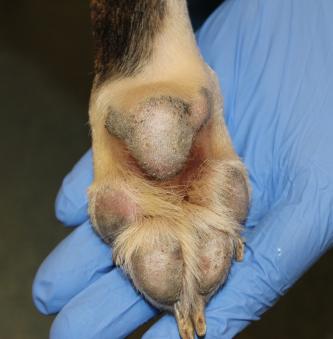-
About
- Leadership & Faculty
- News & Events
-
Academics
- Graduate
- Advanced Clinical Training
- Continuing Education
- Academic Departments
- Academic Offices
- Simulation Experiences
-
Student Life
- Offices
-
Research
-
Hospitals & Clinics
- Emergency Care
- Hospital Services
-
Community Outreach
- Volunteer
Clinical Case Challenge
A Dog with Sloughed Paw Pads, Oral Blisters, and Skin Lesions

A three-year-old mountain cur, Wahkhan, presented to Henry and Lois Foster Hospital for Small Animals at Cummings School of Veterinary Medicine at Tufts University with sloughed paw pads, oral blisters, and skin lesions. He has suffered from severe skin problems since puppyhood that have progressed painfully for the dog.
History
Wahkhan has a history of lesions in his ears and all over his skin. Previous treatments failed to stop the condition from worsening. Wahkhan’s owner brought him to the emergency room at Foster Hospital in January of this year, due to the painfulness and spread of the lesions, blisters in his mouth, and sloughing on all the dog’s paw pads.
Can you solve the case of the month?
Determine which diagnostics and treatments are required
After an initial exam and ordering a biopsy, the Emergency and Critical Care (ECC) team requested a consultation from Foster Hospital’s Dermatology team, which suspected an autoimmune condition.
“The main thing was the severity of the lesions. That’s uncommon, a rare disease that’s not always easy to recognize. We needed pathology and a biopsy,” said Dr. Ramón Almela, veterinary dermatologist and assistant professor at Cummings School of Veterinary Medicine. Dr. Almela specializes in treating skin conditions in dogs, cats, horses, farm animals, and exotic species.
While waiting for the biopsy results, the doctors treated Wahkhan with medication to mitigate his pain. Bandages and cream were administered to help the dog heal and also to prevent infection from the sloughing of his skin.
The biopsy revealed that Wahkhan has a rare autoimmune disease, a type of cytotoxic dermatitis falling into the Erythema Multiforme spectrum. While autoimmune conditions can be caused by infection, cancer, drug reactions, or at birth, most are idiopathic, where the trigger can’t be identified, as in Wahkhan’s case. The biopsy was sent to a pathologist who specializes in skin diseases.
The ECC, Dermatology, and Pathology teams agreed to treat Wahkhan with prednisone at high doses to bring the symptoms under control, and to continue the high dosage until the disease lessens or enters remission.
“Once he was placed on treatment, Wahkhan showed dramatic improvement,” said Dr. Almela. “After a couple of weeks, he was acting back to normal, eating fine, his paws were healing, and he no longer needed bandages. He was getting comfortable and his lesions were healing quickly.”
When Wahkhan returned to Foster Hospital for a recheck in February, most of the lesions were either in the process of healing or fully healed. His owner recently reported that Wahkhan continues to fare well—his feet are completely healed and he has not relapsed.
“We plan to slowly taper the prednisone until the point when his response abates and there’s no relapse,” said Dr. Almela. “Some dogs are fine after treatment, but in other cases if the dog starts to relapse while tapering medication, that’s an indication they need more long-term immunosuppressant medications. It’s a process. As we’ve decreased the dose with Wahkhan, we haven’t had any relapse so far.”
Dr. Almela also noted the dedication of the owner to Wahkhan, who will return to Foster Hospital in April for another recheck. “It was a happy ending—a huge improvement and relief for the patient and the family.”
Comments from Cummings School’s Dermatology Team
“When there’s a case that’s atypical or a rare disease, it’s important to recognize if anything else is going on beyond the skin—to do bloodwork, a full physical exam, and consult other specialists,” said Dr. Almela. “We discussed with other specialists the most likely diagnosis of this disease before thinking of a treatment plan.”
Dr. Almela explained that medications administered to Wahkhan to treat his lesions in the past, for example, could impact the results of the biopsy. He stressed the importance of immunosuppressants and wound care with pain management to treat this condition in particular.
“With rare diseases, consult with other specialists to apply more knowledge for the diagnostics, biopsy, and management of the disease. Get input and options at every step, from anesthesia to the ECC team to whatever specialty is needed in a challenging case.”
Department:
Foster Hospital for Small Animals

